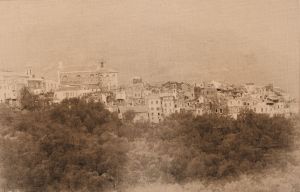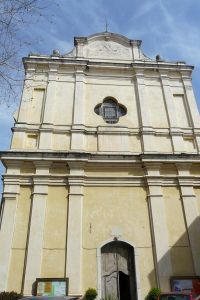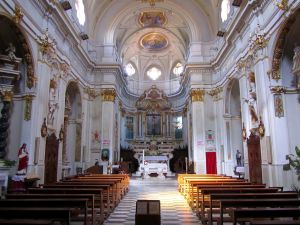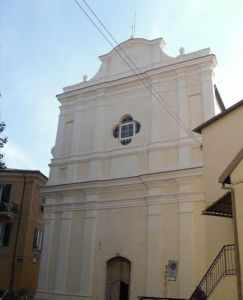The parish church of Poggio
The present church of Poggio does not preserve any trace of the original medieval chapel, which must have been characterized by a rural simplicity in harmony with the modest architectural structure that still today constitutes a qualifying element of the ancient town centre.
 Due to the distance from Sanremo, with the procedure that had already taken place for Coldirodi, in 1452 the inhabitants of Poggio officially asked the Bishop of Albenga, on whom the territory of Sanremo depended at the time, for permission to detach their branch church from that of San Siro.
Due to the distance from Sanremo, with the procedure that had already taken place for Coldirodi, in 1452 the inhabitants of Poggio officially asked the Bishop of Albenga, on whom the territory of Sanremo depended at the time, for permission to detach their branch church from that of San Siro.
In 1452, on 9 November, the notary Luca Corso d'Albenga signed the deed of division from the church of San Siro, after having received the consent to the split by the San Siro provost, and the activity of three elected arbitrators to resolve the matter, at the same time exempting the inhabitants of Poggio from the general payment of tithes to San Siro, but obliging them to pay an annual census of ten florins to the provost of Sanremo.
The elevation to parish dignity of the church of Poggio is an irrefutable proof of the particular importance assumed by the village of the hinterland of Sanremo in the local area, especially in consideration of the importance of the roads towards Ceriana and Baiardo, as well as the main routes of transhumance.  In the same year of the assumption of the parish title, the building underwent a first renovation with a considerable enlargement of the architectural structure of the church, which was solemnly consecrated by the Bishop of Albenga Leonardo Marchese on 10th September 1488.
In the same year of the assumption of the parish title, the building underwent a first renovation with a considerable enlargement of the architectural structure of the church, which was solemnly consecrated by the Bishop of Albenga Leonardo Marchese on 10th September 1488.
In 1799, the rector took the title of Archpriest.
However, the structural conditions of the building were still quite precarious, as clearly attested by the dispositions issued in 1586 by the apostolic visitor Nicolò Mascardi, who prescribed that the walls be whitewashed with lime and that the connected ground of tomb slabs be paved with stones.
In 1590 other restoration works were carried out, while between 1639 and 1645 a more massive intervention was carried out with the construction of the new choir, the strengthening of the east walls, the enlargement of the sacristy and above all the lengthening of the body of the church to occupy the sediments of houses situated in the rear part of the building, thus bypassing the adjoining road which, however, is still accessible even though it is covered by a series of archivolts.
In the meantime, on 31 December 1638 the consuls of Poggio had asked the Municipality of Sanremo for subsidies to carry out some restoration work in the rectory, which proved to be unsafe, but it was only on 22 August 1692 that the Sanremo Town Council examined the plans for the restoration of the church in Poggio, granting a grant of 75 lire five years later for the execution of the work to consolidate the architectural structure of the building. It was only from the eighteenth century onwards, however, that the church became the object of a profound renovation with the creation of an abundant plastic decoration in stucco and paintings of the side chapels. Nowadays the church is a single nave building according to the traditional forms of the Baroque age, with six side chapels, three on each side, each with an altar, formerly under the jurisdiction of the companies. The side altars have the back wall still decorated in stucco, with partially gilded cornices surmounted by putti, inside which are placed paintings of the seventeenth-eighteenth century, while the canteens have been partially changed or integrated. Even the entrance portal, recently recovered, represents a conspicuous example of the wooden production of the second half of the eighteenth century.
Nowadays the church is a single nave building according to the traditional forms of the Baroque age, with six side chapels, three on each side, each with an altar, formerly under the jurisdiction of the companies. The side altars have the back wall still decorated in stucco, with partially gilded cornices surmounted by putti, inside which are placed paintings of the seventeenth-eighteenth century, while the canteens have been partially changed or integrated. Even the entrance portal, recently recovered, represents a conspicuous example of the wooden production of the second half of the eighteenth century.
Among the most significant canvases are the one depicting Saint Catherine and the Guardian Angel in adoration of Our Lady of Good Counsel, a work made by an unknown painter from western Liguria in the 18th century in the manner of Maurizio Carrega, placed above the altar of the first chapel on the left side of the nave; the painting Finding of the Cross, made by an unknown Ligurian painter from the 17th century, placed above the altar of the second chapel and recently restored; The Death of St. Joseph, a work of the second half of the 18th century by an unknown Ligurian artist from the west of Liguria, located in the third chapel on the right side of the nave; the Madonna and Child Jesus, St. Joseph, St. Paul and St. James, painted by an unknown painter from western Liguria in the second half of the 17th century, located on the back wall of the first chapel, and St. John the Baptist, painted by an anonymous Ligurian painter from the 20th century and located on the right side of the first chapel.
The presbyterial area is occupied instead by a marble altar dating back to the 18th century, on which a precious wooden Crucifix is placed. The area at the back reserved for singers is enriched by an artistic eighteenth-century walnut choir decorated with small roundels with prints of saints in the selvedges. On the back wall is reproduced the effigy of the titular saint of the church, The Glory of Saint Margherita, made in the last quarter of the eighteenth century by a painter trained in the circle of Maurizio Carrega, and enclosed in a stucco  frame partially gilded and decorated with angelic figures, which can be placed in the context of the completion of the eighteenth-century decoration of the church, with evident reference to a language influenced by the baroque classicism of the Roman matrix.
frame partially gilded and decorated with angelic figures, which can be placed in the context of the completion of the eighteenth-century decoration of the church, with evident reference to a language influenced by the baroque classicism of the Roman matrix.
In the sacristy, created inside a room on the right side of the building, there are also two works of considerable interest: a San Vincenzo de' Paoli, made by an unknown Ligurian painter from the first half of the
18th century, and a Guardian Angel and cardinal saint, executed by an anonymous Ligurian artist in the first half of the 17th century.
The church also houses a statue of the Virgin of the Rosary, almost certainly commissioned by the local Compagnia del Rosario and made in the second half of the seventeenth century by an unknown Genoese artist to be placed in the niche above the altar of the third chapel on the left side of the nave, and a sculpture of the Immaculate Madonna, made in a Genoese workshop during the eighteenth century and placed in a niche above the altar of the second chapel on the right side of the nave. On the counter-façade, inside a wooden chancel, there is an organ built in January 1884 by the organists of Novara Paolo and Luigi Mentasti, authors of at least eight other instruments, among which exist and known only through documentary sources, scattered in various sacred buildings of the Diocese intemelia.
(text source: Andrea Gandolfo - photo source: WEB and personal archive)




